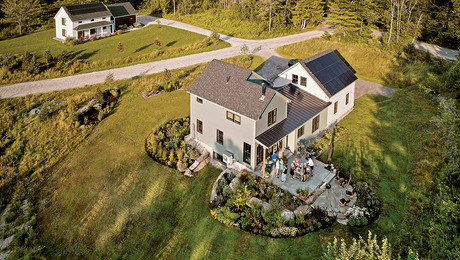Doing some work on a house that has some can lights with either rectangular or square “dirt” patches. There isn’t access to them, but they are in a fairly recent room addition (10-12 yrs ago maybe), with only a roof above them. I think it is insulated with fiberglass batts, but not totally sure. Probably only a couple of feet from top of can lights to the roof.
It’s not where someone forgot to paint.
I was thinking maybe it was an electrostatic build up of dirt caused by the power in the can lights? Anybody know what the cause of this is and what can be done about it?
Thanks,
Casey


















Replies
Cold condensation
The darkness could be a result of light condensation on a cold surface. If the insulation is stopped short of the can it could allow the drywall to be colder in that area. The tiny soot particles emitted by cigarettes, candle burning, kerosene space heaters and wood burners seem to collect there. Usually seen as dark lines on exterior walls (studs).
maybe.
Calvin's on to something
In addition to the light condensation caused by "missing" insulation which Calvin mentions - the square or rectangular shape of the dirt patches is the tip off.
A non-insulation contact can has a bunch of holes in it which can function as a very active chimney which draws even more particulate matter to the area around the cans - depositing even more dirt.
I saw a CA study which claimed a non-airtight can could move several cubic feet of conditioned air per minute into the unconditioned space above.
Solutions? Can't think of a quick or easy one. Remove old cans; insulate; replace with air tight, IC cans; repair and paint ceiling.
Jim
Best fix, short of replacing the can, is to climb into the attic and build a box around it. Generally drywall is used for the box -- it can just be tacked together however, then the joints sealed with blobs of caulk or drywall mud.
Attic boxes
From the OP, I got the impression there was no accessible space above the cans.
Something to the effect of "only a couple of feet to the roof".....
Jim
I tend to agree with both previous posts ... it could be result of cold surfaces or from air flow (in or out). Either way it is a sign of an energy weak point. If in a cold/snow climate, I'm guessing they have had some ice damming. People slap these dang recessed cans in willy nilly everywhere 'cause they are 'in' or whatever ... but don't do a good job to ensure they aren't just punchin' holes in the ceiling.
Could also be the insulation is packed around the cans and the discoloration is charring.
Austrailia started an insulation incentive awhile back, the number of listed insulation installers suddenly jumped from250 to 7000 in one area, with an attendant increase in house fires blamed on insulation errors, etc..
It can be due to condensation from the cold, or it can be dust that's collected due to air flowing through the light. My guess would be the latter, especially if the lights are used with some frequency (which would keep them warm).
You can tell which by examining the dust pattern closely -- if due to a draft there will be a clear pattern due to the airflow, while if due to condensation there will be a less organized pattern.
There are two theories for dirt accumulations on drywall:
1. The air movement impaction theory; and,
2. The condensation theory.
The first is that where there are studs/joists, there is a micro-climate from slight temp differences, and air swirls there and thus dust/dirt particles in the air hit the wall there more often and thus there is a greater build-up of dirt.
The second is that dirt dust will cling to areas where there is missing/lower insulation and thus lower temps and, thus, and sometimes condensation.
I really like the "air movement impaction" theory myself, it seems so cool.
But it doesn't explain areas such as you report where the buildup is not associated with framing, so I vote (reluctantly) for the condensation theory.
I've seen many cases where you can see "jets" -- streaks of light and dark -- radiating out from the fixture. These are clearly areas where the airflow through the trim ring is high or low.
I've also seen joist "shadowing" on a number of occasions (especially when candles or a fireplace are a factor), so I know that thermal issues can cause the dirt/soot to accumulate (though I'm not convinced by either the moisture or airflow proponents here).
>>(though I'm not convinced
>>(though I'm not convinced by either the moisture or airflow proponents here).
Have a theory?
The soot collection appears to be connected to electrostatic effects, and I'm not sure how either airflow or moisture figures in. It could just be that the reduced Brownian motion in cooler areas allows more soot to settle, but the effect seems to pronounced for that to be the primary cause.
Thanks to everyone who replied. As always lots of great input here. I'll try to post some pictures later to give a better idea of what it looks like, but I'm guessing the lights are going to have to come down one way or another.
Peace,
Casey
In some cases it might be possible to take off the trim rings and caulk around the fixture, if the fixture itself is well-sealed but just poorly installed. But in other cases the fixture blocks air about as well as a screen door on a dog porch.